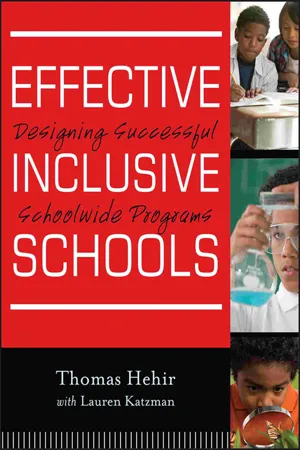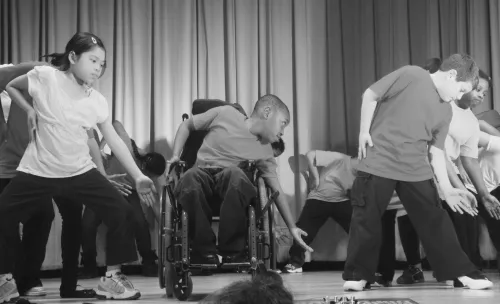Looking Back with Pride
Dr. Henderson has reason to be proud of his students and teachers. Since 1989, when he became the school's principal, the O'Hearn had grown from an underperforming school with student vacancies to a school with a higher percentage of students with and without disabilities passing the Massachusetts Comprehensive Assessment System (MCAS) in the fourth grade than the overall percentage of the Boston public schools.1 Instead of vacancies, the school now has a waiting list of parents who want their children, those with and those without disabilities, to attend. Since 1989, the school has evolved from providing special education services in segregated settings, such as special education classes and resources rooms, to providing the overwhelming majority of their special education services in the general education classroom.
Mary, a parent of one child with a disability and one without a disability who both attended the O'Hearn, explained her appreciation for the school: “The children there really end up learning about [and] caring for others, just the diversity of the world. Not everybody's on the same page and same level. And there's been times when. . .my so-called typical [daughter] has gone places and. . .people are really surprised [about] how she doesn't stare when she meets somebody. She can talk to any child, is not afraid. And they go, ‘Wow.’ And I'm like, ‘She goes to the O'Hearn.’”
The O'Hearn is located in Dorchester, a section of Boston with a mix of African American, Irish, and Vietnamese residents. Most students were enrolled at the O'Hearn through a lottery process. Boston has a rather elaborate student assignment process in which parents were given a number of schools they could choose from, and each school is then subject to a lottery. The choice system gave preference to children with siblings who attended the school and whether the school was designated as the child's “walk” school preference.
During the 2004–2005 school year, the O'Hearn enrolled 221 students. Approximately 47 percent were African American, 28 percent White, 8 percent Asian, 6 percent multi-race, and 5 percent were Hispanic or Native American. (See Table B.5 in Appendix B.) Of this population of students, 34 percent received special education services, a percentage high above the national average of approximately 12 percent. The range of student disabilities was vast. The majority of students had milder and high-incidence disabilities, such as learning disabilities. There was also a population of students with more significant and low-incidence disabilities, such as intellectual disabilities, autism, Down syndrome, cerebral palsy, and students who were medically fragile.
Each classroom at the O'Hearn had two teachers, one certified in elementary education and the other in special education. With such a high percentage of students with disabilities in the school, Henderson was able to garner enough resources to make possible this staffing. Though there was also a paraprofessional assigned to each classroom, only one paraprofessional was assigned to work with one student, a boy who had brittle bone syndrome and required individual adult supervision to ensure his physical safety.
The only special education classroom at the O'Hearn was called the Baking Café, a room used collaboratively by the speech and language therapist and occupational therapist to work with students with significant intellectual disabilities to organize and run the school store, to deliver school supplies to classrooms, and to work on functional skills such as cooking. Aside from these activities, speech and language and occupational therapies occurred in the general education classroom.
The classrooms at the O'Hearn were brimming with activity. Teachers were in and out of each other's classes, bringing suggestions, working with students, problem-solving students’ needs together. Similarly, students worked collaboratively with their teachers and their peers in the classroom. In one first grade class, students were preparing for a publishing party to which they invited family members and others in the school to show and read from the books they had created. Students were asked to choose one of their stories from the stack that they had written, go through the story to see if they could add more sentences, make sure that each sentence had a period, and make sure that their illustrations matched their words. Conversations between students about their books were serious. These first graders were asking each other detailed questions about their illustrations and how what they drew was in their story. They listened to each other read and asked specific questions about their stories. These six-year-olds took great pride in their work.
In another first grade class, students were read part of a story and were asked to turn to their partners to talk about how one of the characters was feeling. The teacher called this activity “accountable talk” because students were working to explain or to be accountable for their ideas. Once the story was completed, students broke into small groups to work on their reader's workshop activities. “Letter Blocks” was an activity in which students were asked to use four letters on blocks to “mix it, fix it, check it.” Another activity was to work on a computer program that supplemented phonetic instruction. The third activity was to work in their guided reading groups run by each of the two teachers. In one of these groups, students were asked to write their names on a piece of paper. For the student in the group who could not write his name, there was a name stamp ready for his use. Accommodations like this were typical at the O'Hearn, and the school was a pilot school for the use of Kurzweil technology, a text-to-speech hardware, as an accommodation eligible for use with the MCAS.
A Parent Influences Federal Policy
In 1994 I (Tom Hehir) visited the O'Hearn with then-Secretary of Education Richard Riley and Assistant Secretary Judy Heumann. Secretary Riley wanted to see an inclusive school because inclusion was such a controversial issue. I told him about the O'Hearn and to my astonishment he said, “Let's go visit it.”
After visiting classrooms we met with several parents of children with disabilities, who spoke about how their children had thrived in inclusive classrooms, developing communication skills, making friends, and achieving academically. One mother whose three non-disabled children attended the O'Hearn told us her oldest daughter had “tested for advanced classes” (referring to Boston's gifted program). When she and her husband visited the program that was housed in another school, they found that the students in the gifted program were doing lower-level work than her daughter was doing in her inclusive class. They decided to keep her at the O'Hearn, where “every child has an individualized program.” She went on to say that even more important to her and husband was their kindergartner's experience: the li...

